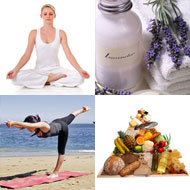- Aromatherapy (36)
- Benefits of Yoga (282)
- Home Remedies (1087)
- massage therapy (9)
- Preventive Therapy (135)
- Running (41)
- Skin Care (15)
- Stress Relief (25)
- Stretching (5)
- walking (33)
- Womens Health (14)
- Yoga Benefits for Pregnant Women (16)
- Yoga Benefits for Students (3)
- Yoga for Children (11)
- Yoga for Holistic Living (37)
- Yoga for Midlife Crisis (3)
- Yoga for Senior Citizens (2)
- Yoga for the Workplace (1)
- Yoga Health Tips (185)
- Yoga Practice during Menstruation (5)
Types Of Yoga For Sleep Disorders

Sleeplessness or insomnia is a disorder in which a person experiences poor sleep or has trouble sleeping. This can lead to mood disturbance, lack of motivation, decreased attention span, low energy levels, and a general sense of tiredness. As sleep is necessary for a healthy body and its functioning, it is necessary to find ways to improve your sleep pattern. A simple and effective method is to try yoga for sleep, especially if your sleeplessness is stress related.
Yoga is a discipline that creates balance and harmony between the mind, body and the universe around. It promotes awareness and focus and reduces feeling of anxiety and stress. Yoga stimulates your nervous system, especially the brain; its practice will improve blood circulation to the sleep centre in the brain which will help in normalizing the sleep cycle. All yoga poses for sleep will keep you fit and active during the day so that your body is naturally ready to rest at night. There are also certain poses that will quiet and calm you. Forward bends such as the Standing Forward Bend, Downward Facing Dog Pose, Head to Knee Pose, and Seated Forward Bend, all help to stimulate the relaxation response and calm the nervous system and quieten the brain. You can also try supported supine poses like the Reclining Bound Angle Pose, the Bridge Pose and Reclining Hero Pose. The Supported Shoulder Stand can also be done immediately before bed to prepare your body for sleep. All inversions like the Supported Headstand, Plow Pose, and Legs Up The Wall Pose are helpful if the cause of sleeplessness is hormonal. You can also practice the Complete Breath, a gently rhythmic breathing cycle while resting on your bed. This technique rests your mind and body by focusing on the sound and rhythm of the breath, it can help you to fall back to sleep if you wake up during the night or help at anytime to still your buzzing mind.
Gentle stretching before going to bed aids relaxation and releases tension. The Happy Baby pose releases stress from the lower back and hips. The Goddess Pose opens the groins. The Corpse Pose which ends every yoga session is a good way to close your day. As you lie in bed, focus on each part of your body and relax it consciously. You can begin with the toes, move up to the legs and arms, through the torso to the neck, face and head. You can spend a few minutes first focusing in your breath, not on the thoughts cluttering your mind. All this yoga exercises helps in clearing the busy mind and relaxing it for sound sleep.
Meditation helps greatly in inducing better sleep. Usually the mind is restless and anxious because of past traumas or worries for the future. The practice of sitting silently and meditating teaches you to focus on the present. It also puts a stop to physical and mental conversation and gives your mind a rest from disturbing thoughts, memories and worries.
You can also do some other things. Eat your last meal at least three hours before bed time and have a snack before sleeping. You can have a warm bath, avoid stimulating drinks and keep your bedroom clutter free, and let in some fresh air. This yoga postures for sleep and yoga techniques that you practice will balance your mind and body and allow you to live well, make the right decisions during the day and keep your mind calm at night. This should ensure a good night’s sleep!
- RSS Feeds -
- All posts
- All comments
- Yoga for Dark Circles under Eye The cases of dark circles under the eyes are frequent, but little proven theo...
- Yoga To Relax You experience real relaxation in your body, mind and heart when you expend l...
- Yoga and Epilepsy Epilepsy is a disorder associated with the central nervous system. The centra...
- Bedtime yoga As bedtime approaches, do you find it difficult to let go of the worries of t...